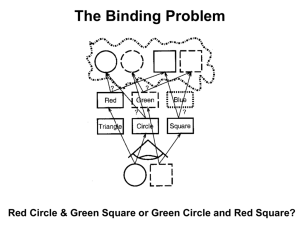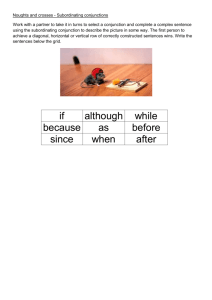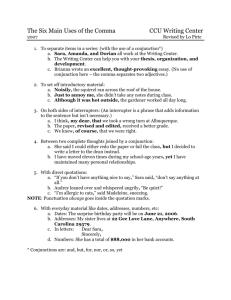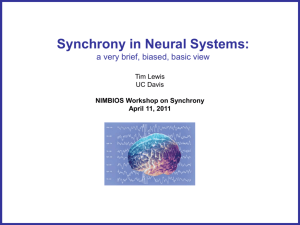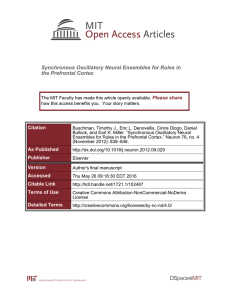Sensation & Perception
advertisement
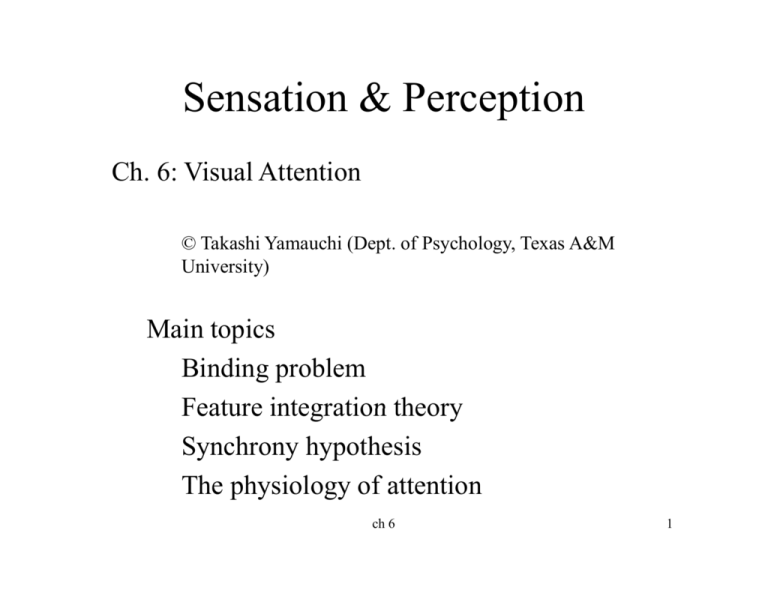
Sensation & Perception Ch. 6: Visual Attention © Takashi Yamauchi (Dept. of Psychology, Texas A&M University) Main topics Binding problem Feature integration theory Synchrony hypothesis The physiology of attention ch 6 1 “neuroenhancing drugs” • http://www.newyorker.com/reporting/2009/ 04/27/090427fa_fact_talbot ch 6 2 What is attention for? • Selecting information • Enhancing information • Combining C bi i information i f ti • What role does attention play in combining/integrating information? • What physiological mechanism underlie the integrative process? ch 6 3 Selecting information • The retina receives so much information. ch 6 4 • Attention helps select information. • This is necessarily because of the way the eye is structured. – Most cones reside at the fovea. – To get accurate information about a scene, we need to select carefully particular parts of a scene. ch 6 5 Visual Attention • Visual attention and eye movement • Eye tracker • Eye tracking machine and demo – http://www.youtube.com/watch?v=lGehsY7pcrc ch 6 6 ch 6 7 ch 6 8 Attention also enhances perception • If we don don’tt attend, attend we lose information. information • If we attend, d we understand d d bbetter. ch 6 9 Attention helps integrate information • Binding problem • Feature integration theory ch 6 10 Binding problem ch 6 11 Two visual pathways (what & where/how systems) ch 6 Image from Neuroscience, 2nd Ed. (2000). 12 Columnar organization • Ne Neurons rons that respond to the same orientation are packed in the same column Image courtesy of Dr. Paul Wellman and ch Neuroscience, 2nd Ed. (2000). 6 13 Distributed coding • g Combining input ch 6 14 Binding problem • The modular organization of the brain poses an essential problem. – How does the brain combine information? – How does it bind features that are processed separately? ch 6 15 • Feature integration theory • by Treisman & Gelade – Attention Att ti plays l a central t l role l in i solving l i the binding problem. – Attention helps p organize g information. ch 6 16 Attention and Figure-ground segregation Depending on where you look at, the figure and the ground p y switch rapidly. Attention plays some role in determining the ch 6 figure and the ground. 17 Attention and 3D structure Depending on where to look at, you get different kinds of 3D perception. ch 6 18 ch 6 19 Damage to the parietal lobe creates bi di errors. binding ch 6 20 ch 6 21 Copies of the black (A) and the white th hit (B) vertical ti l contour. Copies of the black (A) and the white (B) diagonal contour. ch 6 22 Feature integration theory • Attention combines the information from the what and where systems. ch 6 23 What can you predict from this theory? • If you can’t attend, you can’t combine information. • Illusionary conjunction ch 6 24 Demonstration • I will show you a scene quickly. • Report first the black numbers. • Report what you see at each of the 4 locations. +++ ch 6 25 • Report first the black numbers. • Report what you saw at each of the 4 locations. ch 6 26 ch 6 27 Illusionary conjunctions • We tend to put different features from different objects j together. g • brain damaged patients (parietal lobe) show illusionary conjunctions even when they view the stimuli for 10 seconds. seconds ch 6 28 Visual search experiments • Looking for the target • Feature search – You look for a single feature. – you don’t need attention • C Conjunction j i search – You need to combine two or more features (color and orientation) – yyou need attention ch 6 29 Visual search experiments • Looking for the target Color T: ggreen D: green Orientation horizontal vertical Color T: green D1: green D2: red Orientation horizontal vertical horizontal ch 6 30 Find Which is more difficult? ch 6 31 Find Which is more difficult? ch 6 32 Feature binding and attention (Treisman, 1988) Experiments: Task: Given a stimulus frame containing visual items subjects were asked to indicate items, whether or not a target item was present in the frame. frame ch 6 33 Feature search vs. vs conjunction search • Feature search – The target item has a unique feature feature. • Conjunction search – need d to combine bi features f need d attention. i – Because you can attend only one item at a time, the conjunction search becomes more difficult when more items are in the stimulus frame. ch 6 34 Generality of the results: Feature search Conjunction search ch 6 35 Experiments: • Measure accuracy and response times ((conjunction j cases vs. non-conjunction j cases) ch 6 36 ch 6 37 Response time 1000 ms 500ms ch 6 # of distractors 38 Response time 1000 ms 500ms ch 6 # of distracters 39 • Patients with damage to the parietal lobe have difficulty y with conjunction j searches. • (Ambridge et al., 1999) ch 6 40 Some problems with FIT • Distinctiveness of features can also create p phenomenon. p the ppop-out ch 6 41 The physiology of attention • How do you combine features? • Synchrony y y hypothesis yp • When neurons in different parts of the cortex are firing to the same object, the pattern of firing is synchronized (they fire at the same time, and in the same manner). • So when neurons are firing in synchrony, the corresponding di features f are bound b d together. h ch 6 42 • Separate neurons respond to color, contours, textures, so on. • Synchrony hypothesis: – When the features come from the same object, th these neurons fi fire att the same time in the same manner manner. – This synchronicity of firing binds features. • Attention increases synchrony ch 6 43 Binding problem and schizophrenia • • People suffering from schizophrenia often experience hallucination. An EEG study y shows that brain waves of schizophrenic p ppatients are not synchronous compared to normal control subjects. • Spencer, et al (2005). Neural synchrony indexes disordered perception and cognition in schizophrenia. Proceedings of National Academy of Sciences, 101, 17288-17293. ch 6 44 Attention and Autism • Impaired social interaction and communication – Often fail to understand what other people think. • Far more autistic boys than autistic girls (4:1) • Overrepresented in children whose parents / grand parents are engineers – (Baron-Cohen et al.; Autism, 1997, 1, 153-163) • substantial genetic component ch 6 45 • Video clip – Invisible wall – Autism and symptoms (3:56) • http://www.youtube.com/watch?v=FuWWie1DlJY ch 6 46 Attention and Autism Eye movement: normall (white ( hi markers) vs. autistic viewers (black ( markers) ch 6 47

